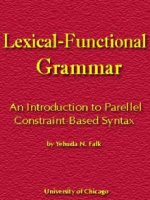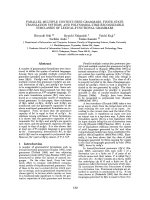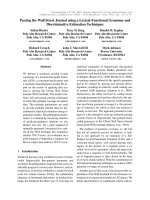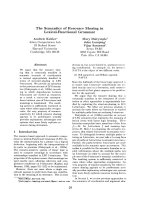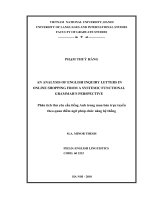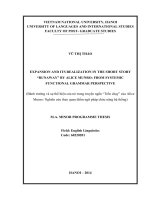Slide presentation Functional Grammar
Bạn đang xem bản rút gọn của tài liệu. Xem và tải ngay bản đầy đủ của tài liệu tại đây (918.97 KB, 90 trang )
Functional
Functional Grammar
Grammar
Supervisor
Supervisor :: Pro.
Pro. Dr
Dr Hoàng
Hoàng
Văn
Văn Vân
Vân
GROUP
GROUP 1
1
11 –– Nguyễn
Nguyễn Thị
Thị Thu
Thu Quỳnh
Quỳnh
22 –– Trần
Trần Thị
Thị Phương
Phương Nhung
Nhung
33 –– Vũ
Vũ Lệ
Lệ Huyền
Huyền
44 –– Phạm
Phạm Hồng
Hồng Phượng
Phượng
55 –– Nguyễn
Nguyễn Phương
Phương Yến
Yến
REVIEW
REVIEW
TEXT
CONTEXT
The context of culture The context of situatio
refers to
the broad
socio-cultural
environment:
- ideology
- social conventions
- institutions
relates to
the specific
situations
within
the socio-cultural
environment
Three aspects of the context
FIELD
FIELD
TENOR
TENOR
MODE
MODE
is
efers to
refers
is the
the
refers
to what
what
refers to
to
relationship
is
relationship the
is
the channel
channel
to
of
between the
the
to be
be talked
talked between
of
or
communispeaker and
and
or written
written speaker
communilistener
about;
cation
listener
about;
cation
or
or the
the writer
writer
and
and reader
reader
It enables people to use language
to enact social relationships,
and is influenced by tenor
The interpersonal metafunction
It enables people to use language
to present experience, and is
influenced by field
The ideational /experiential
metafunction
It enables people to use language
to construct logical and coherent
text
and is influenced by mode
Textual metafunction
Outline
Clause as representation
I. Metafunctions
II.
Ideational
metafunction
and
its
realization through the transitivity system
1. Ideational metafunction
2. Transitivity system
3. The realisations of ideational
metafunction
through
the
transitivity system
3.1. Process and participants
3.2. Other participant functions
3.3. Circumstances
I. Metafunctions
Definition
Different modes of meaning
construed by grammar
Types
Lexico
-grammar
Ideational
(experiential)
Clause as
representation
Interpersonal
Clause as exchange
Textual
Clause as message
Process
Participants
Circumstances
Mood ( subject –
finite )
Residue
Theme
Rheme
Example:
In this job
Anne
We
‘re
working
Theme
Rheme
with
silver
Textual
Mood
Vocative
Interpersonal
Subject Finite
Locative
Actor
Process
Manner Ideational
Figure 1.9: Independence of metafunctions
Outline
I. Metafunctions
II.
Ideational
metafunction
and
its
realization through the transitivity system
1. Ideational metafunction
2. Transitivity system
3. The realisations of ideational
metafunction
through
the
transitivity system
3.1. Process and participants
3.2. Other participant functions
3.3. Circumstances
4. Questions
METAFUNCTIONS
Id
ti
a
e
l
a
on
r
e
t
In
so
r
pe
Experiential
Experiential
Logical
Logical
l
a
n
l
a
tu
x
Te
Grammar of
clause as
representation
Meaning between
clauses in clause
complexes
Ideational metafunction
Ideation focuses on the ‘content’ of a
discourse: what kinds of activities are
undertaken, and how participants in
these activities are described, how
they are classified and what are they
composed of. Ideation is concerned with how our
experience of ‘reality’, material and symbolic, is
construed in discourse.
Participants
(Martin & Rose, 2003, p. 66)
Who does what to whom where and when, how
and why?
Process
Circumstances
Outline
I. Metafunctions
II.
Ideational
metafunction
and
its
realization through the transitivity system
1. Ideational metafunction
2. Transitivity system
3. The realisations of ideational
metafunction
through
the
transitivity system
3.1. Process and participants
3.2. Other participant functions
3.3. Circumstances
4. Transitivity and voice: another
interpretation
Transitivity System
Transitivity
is the
resource for construing
our experience the flux
of 'goings-on‘, as
structural
configurations; each
consisting of a
process, the
participants
Circumstances
Participants
Process
involved in the process,
and circumstances
attendant on it.
Transitivity
structure
(Butt et al., 2003, p.46)
Transitivity system
Process
Process, the essential ingredient, is
about happening, doing, being,
saying, sensing and thinking.
There are many types of processes,
which are realized by verbal groups.
The type of process determines
how participants are labeled.
E.g. Actor: I played football.
Senser: I heard a noise.
Participants
A participant represents the
“thingness” concept that is being
talked about.
It can be a person, place or object
It answers the question Who?
Which? What? To Whom? For
Whom? about the process.
It is most likely realized by a
nominal group.
Circumstances
The background against which
the process takes place.
Circumstance is realized by
adverbial
groups,
prepositional
phrases
or
nominal groups.
Clause as process, participants and circumstances
Exampl
e
The lion
Semanti
c roles
Participant Process
Lexicogramma
r
Nominal
group
chased
Verbal
group
the
tourist
lazily
through the
bush
Participant Circumstance Circumstance
Nominal
group
Adverbial
group
Preposition
al phrase
Outline
I. Metafunctions
II.
Ideational
metafunction
and
its
realization through the transitivity system
1. Ideational metafunction
2. Transitivity system
3. The realisations of ideational
metafunction
through
the
transitivity system
3.1. Process and participants
3.2. Other participant functions
3.3. Circumstances
4. Questions
Process types
3. The realizations of ideational
metafunction through the
transitivity system
3.1. Process and participants
3.1.1. Material process
3.1.2. Mental process
3.1.3. Relational process
3.1.1.Material Processes
Definition
Structure
Example
Types
Properties
